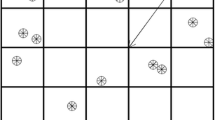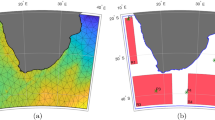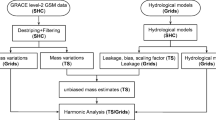Abstract
The mean dynamic topography (MDT) can be computed as the difference between the mean sea level (MSL) and a gravimetric geoid. This requires that both data sets are spectrally consistent. In practice, it is quite common that the resolution of the geoid data is less than the resolution of the MSL data, hence, the latter need to be low-pass filtered before the MDT is computed. For this purpose conventional low-pass filters are inadequate, failing in coastal regions where they run into the undefined MSL signal on the continents. In this paper, we consider the use of a bandlimited, spatially concentrated Slepian basis to obtain a low-resolution approximation of the MSL signal. We compute Slepian functions for the oceans and parts of the oceans and compare the performance of calculating the MDT via this approach with other methods, in particular the iterative spherical harmonic approach in combination with Gaussian low-pass filtering, and various modifications. Based on the numerical experiments, we conclude that none of these methods provide a low-resolution MSL approximation at the sub-decimetre level. In particular, we show that Slepian functions are not appropriate basis functions for this problem, and a Slepian representation of the low-resolution MSL signal suffers from broadband leakage. We also show that a meaningful definition of a low-resolution MSL over incomplete spherical domains involves orthogonal basis functions with additional properties that Slepian functions do not possess. A low-resolution MSL signal, spectrally consistent with a given geoid model, is obtained by a suitable truncation of the expansions of the MSL signal in terms of these orthogonal basis functions. We compute one of these sets of orthogonal basis functions using the Gram–Schmidt orthogonalization for spherical harmonics. For the oceans, we could construct an orthogonal basis only for resolutions equivalent to a spherical harmonic degree 36. The computation of a basis with a higher resolution fails due to inherent instabilities. Regularization reduces the instabilities but destroys the orthogonality and, therefore, provides unrealistic low-resolution MSL approximations. More research is needed to solve the instability problem, perhaps by finding a different orthogonal basis that avoids it altogether.
Article PDF
Similar content being viewed by others
Avoid common mistakes on your manuscript.
References
Albertella A, Rummel R (2009) On the spectral consistency of the altimetric ocean and geoid surface: a one-dimensional example. J Geod 83: 805–815
Albertella A, Sansò F, Sneeuw N (1999) Band-limited functions on a bounded spherical domain: the Slepian problem on the sphere. J Geod 73: 436–447
Albertella A, Savcenko R, Bosch W, Rummel R (2008) Dynamic Ocean Topography—The Geodetic Approach. Technical Report 27, Institut für Astronomische und Physikalische Geodäsie, Forschungseinrichtung Satellitengeodäsie, München
Andersen OB, Knudsen P (2009) DNSC08 mean sea surface and mean dynamic topography models. J Geophys Res (Oceans) 114(C13): C11001. doi:10.1029/2008JC005179
Bingham RJ, Haines K, Hughes CW (2008) Calculating the ocean’s mean dynamic topography from a mean sea surface and a geoid. J Atmospheric Ocean Technol 25: 1808–1822. doi:10.1175/2008JTECHO568.1
Boschi L, Dziewonski AM (1999) High- and low-resolution images of the Earth’s mantle: Implications of different approaches to tomographic modeling. J Geophys Res 104(B11): 25567–25594. doi:10.1029/1999JB900166
Dahlen FA, Simons FJ (2008) Spectral estimation on a sphere in geophysics and cosmology. Geophys J Int 174: 774–807. doi:10.1111/j.1365-246X.2008.03854.x
Freeden W, Michel V (1999) Constructive approximation and numerical methods in geodetic research today—an attempt at a categorization based on an uncertainty principle. J Geod 73(9): 452–465
Golub G, van Loan C (1996) Matrix computations, 3rd edn. Johns Hopkins, Baltimore
González À (2010) Measurement of areas on a sphere using Fibonacci and latitude–longitude lattices. Math Geosci 42(1): 49–64
Grünbaum FA, Longhi L, Perlstadt M (1982) Differential operators commuting with finite convolution integral operators: some non-Abelian examples. SIAM J Appl Math 42(5): 941–955
Guilloux F, Faÿ G, Cardoso J-F (2009) Practical wavalet design on the sphere. Appl Comput Harmon Anal 26: 143–160. doi:10.1016/j.acha.2008.03.003
Hwang C (1991) Orthogonal functions over the oceans and applications to the determination of orbit error, geoid and sea surface topography from satellite altimetry. Technical Report 414, Department of Geodetic Science and Surveying, The Ohio State University, Columbus
Hwang C (1993) Spectral analysis using orthonormal functions with a case study on the sea surface topography. Geophys J Int 115: 1148–1160. doi:10.1111/j.1365-246X.1993.tb01517.x
Jayne SR (2006) Circulation of the North Atlantic Ocean from altimetry and the gravity recovery and climate experiment geoid. J Geophys Res 111: C03005. doi:10.1029/2005JC003128
Jekeli C (1981) Alternative methods to smooth the Earth’s gravity field. Report 327, Department of Geodetic Science and Surveying, The Ohio State University, Columbus, Ohio
Kusche J, Schrama E (2005) Surface mass redistribution inversion from global GPS deformation and gravity recovery and climate experiment (GRACE) gravity data. J Geophys Res 110. doi:10.1029/2004JB003556
Landau HJ, Pollak HO (1961) Prolate spheroidal wave functions, Fourier analysis and uncertainty-II. Bell Syst Tech J 40(1): 65–84
Landau HJ, Pollak HO (1962) Prolate spheroidal wave functions, Fourier analysis and uncertainty-III: the dimension of the space of essentially time- and band-limited signals. Bell Syst Tech J 41(4): 1295–1363
Losch M, Sloyan BM, Schröter J, Sneeuw N (2002) Box inverse models, altimetry and the geoid: Problems with the omission error. J Geophys Res 107: 3078. doi:10.1029/2001JC000855
Pail R, Plank G, Schuh W-D (2001) Spatially restricted data distributions on the sphere: the method of orthonormalized functions and applications. J Geod 75: 44–56
Pavlis N, Holmes S, Kenyon S, Factor J (2008) An earth gravitational model to degree 2160: Egm2008, 2008. http://earth-info.nga.mil/GandG/wgs84/gravitymod/egm2008/first_release.html presented at the 2008 General Assembly of the European Geosciences Union, Vienna, Austria, April 13–18
Schachtschneider R, Holschneider M, Mandea M (2010) Error distribution in regional inversion of potential field data. Geophys J Int 181: 1428–1440. doi:10.1111/j.1365-246X.2010.04598.x
Schott J-J, Thébault E (2011) Modelling the earth’s magnetic field from global to regional scales. In: Mandea M, Korte M (eds) Geomagnetic Observations and Models. IAGA Special Sopron Book Ser., vol. 5. Springer, Berlin
Simons FJ (2010) Slepian functions and their use in signal estimation and spectral analysis. In: Freeden W, Nashed MZ, Sonar T (eds) Handbook of Geomathematics,vol. 30. Springer, Berlin, pp 891–923. doi:10.1007/978-3-642-01546-5_30
Simons FJ, Dahlen FA (2006) Spherical Slepian functions and the polar gap in geodesy. Geophys J Int 166: 1039–1061. doi:10.1111/j.1365-246X.2006.03065.x
Simons FJ, Dahlen FA, Wieczorek MA (2006) Spatiospectral concentration on a sphere. SIAM Rev 48(3): 504–536. doi:10.1137/S0036144504445765
Simons FJ, Hawthorne JC, Beggan CD (2009) Efficient analysis and representation of geophysical processes using localized spherical basis functions. In: Society of Photo-Optical Instrumentation Engineers (SPIE) Conference Series. Presented at the Society of Photo-Optical Instrumentation Engineers (SPIE) Conference, vol. 7446, Aug. 2009. doi:10.1117/12.825730
Simons FJ, Wang DV (2011) Spatiospectral concentration in the Cartesian plane. Int. J. Geomath. doi:10.1007/s13137-011-0016-z
Slepian D, Pollak HO (1961) Prolate spheroidal wave functions, Fourier analysis and uncertainty-I. Bell Syst Tech J 40(1): 43–63
Tapley BD, Chambers DP, Bettadpur S, Ries JC (2003) Large scale ocean circulation from the GRACE GGM01 Geoid. Geophys Res Lett 30(22): 2200001
Trampert J, Snieder R (1996) Model estimations biased by truncated expansions: possible artifacts in seismic tomography. Science 271(5253): 1257–1260. doi:10.1126/science.271.5253.1257
US National Geospatial-Intelligence Agency EGM Development Team (2010) Egm2008-files & products for oceanographic applications. http://earth-info.nga.mil/GandG/wgs84/gravitymod/egm2008/oceano.html Accessed July, 2010
Vianna ML, Menezes VV, Chambers DP (2007) A high resolution satellite-only GRACE-based mean dynamic topography of the South Atlantic Ocean. Geophys Res Lett 34: 24604. doi:10.1029/2007GL031912
Wieczorek MA, Simons FJ (2007) Minimum-variance spectral analysis on the sphere. J Fourier Anal Appl 13(6): 665–692. doi:10.1007/s00041-006-6904-1
Wunsch C, Gaposchkin EM (1980) On using satellite altimetry to determine the general circulation of the oceans with application to geoid improvement. Rev Geophys 18: 725–745. doi:10.1029/RG018i004p00725
Xu P (1998) Truncated SVD methods for discrete linear ill-posed problems. Geophys J Int 135(2): 505–541
Open Access
This article is distributed under the terms of the Creative Commons Attribution License which permits any use, distribution, and reproduction in any medium, provided the original author(s) and the source are credited.
Author information
Authors and Affiliations
Corresponding author
Rights and permissions
Open Access This article is distributed under the terms of the Creative Commons Attribution 2.0 International License (https://creativecommons.org/licenses/by/2.0), which permits unrestricted use, distribution, and reproduction in any medium, provided the original work is properly cited.
About this article
Cite this article
Slobbe, D.C., Simons, F.J. & Klees, R. The spherical Slepian basis as a means to obtain spectral consistency between mean sea level and the geoid. J Geod 86, 609–628 (2012). https://doi.org/10.1007/s00190-012-0543-x
Received:
Accepted:
Published:
Issue Date:
DOI: https://doi.org/10.1007/s00190-012-0543-x




